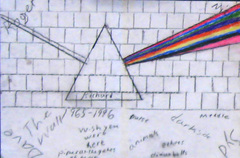Student Profiles
Teaching to Strengths
Student intelligence profiles are unique. Each person is a combination of intelligences. This diversity requires teaching to each student's strengths. It is through their strengths that intrinsic motivation for learning develops. Affirmation of strengths occurs in an environment where differences are expected outcomes.
The goal of instruction is to help students demonstrates curricular goals using their strengths. It is through each individual student that meaning is connected to information. After several choice-based exploration pieces, students are asked to exhibit three pieces which are related in some way. This critique permits peers to give feedback and allows the individual student to verbalize their intent. As an art educator, it is where I can begin to evaluate students for evidence of the elements of art and principles of design.
Student 1 first explored painting with her hands. Touch is a key indicator of bodily-kinesthetic intelligence. Manipulation of materials will often lead students to discover ideas and initiate projects. She took photos of touching the paint, observing the viscosity of the medium.
Student 1 continued with cut and torn paper collages. This piece layered tissue paper to create a relief collage with color and texture, again emphasizing tactile qualities indicative of bodily-kinesthetic strengths.
Here Student 1 continues collage techniques, but a recognizable subject matter emerges in the central figure. Reflecting on the work, she remembers running and the freedom she experienced during childhood. This subject matter is consistent with movement defined by the bodily-kinesthetic intelligence.
Student 2
Student 2 began working with pencil and colored pencil creating a radial design, reflecting mathematical-logical thinking. He used both warm and cool colors. The short spikes of lines moving out from the focal point feel prickly but not menacing. There's a contrast between the yellow focal shape and the black backgound which fades to white giving the colored lines dominance. Contrast is evident in existential intelligence where a student is bringing opposites together. Here, the balance is between light and dark, near and far, perhaps inclusion and exclusion.
In the second piece, Student 2 works from a focal point but composition is more symmetical, definitely mathematical. He continues with colored pencil working with soft warm and cool colors. Lines are primarily angular but also curved. The image is flatter, with just two planes, foreground figure and white background. The design, interestingly, appears to have feet and arms, perhaps a reference to himself, someone else (interpersonal) or a figure that can move (bodily-kinesthetic).
This piece depicts an asymmetical composition that also moves off the edge of the picture plane in one corner. Student 2 is able to see imaginary planes beyond the limits of the paper. Overlapping of lines and shapes also creates more depth in the picture plane than the previous piece.
Student 3
Student 3 is a musician, obviously. His first piece is an album cover from Pink Floyd's "The Wall". The central triangle shape is a prism that breaks white light into the rainbow of colors. He also writes text on the piece in names of people which indicates a connection to others, the interpersonal intelligence. His interpretation of the piece identified the music as his father's favorite, and that he shared a passion for music with his Dad.
In this piece, Student 3 chose a black background with white tempera paint. This contrast shows existential intelligence suggesting a paradox or conflict of some kind. Two parallel and symmetrical shapes move towards each other from the bottom left side and top right side edges of the composition. The angular and intersecting lines are mathematical-logical and create a centralized shape. The dripping of the paint uses its viscosity, indicator of bodily-kinesthetic movement.
In this piece, Student 3 emphasizes a central figure created by the intersection of symmetrical lines moving in from the left and right sides of the picture plane. He also adds colors, warm and cool, surrounding and softening the central dark figure. The student's interpretation of the work his connection with his Dad even though he didn't see him regularly. My interpretation is that this young man had navigated through the absence of his father, acknowledging the sadness and darkness. But he also knows that through music he will find a mutual and vital connection with his father. It's like a puzzle of his family put back together.
Student 4
Student 4 used a pop culture reference depicting love, a heart formed by two hands. It indicates bodily-kinesthetic and interpersonal intelligences. The composition is radial with one foreground plane on a white background. She chose black ink and pen as a medium.
This piece shows two combined works. The background spatter painting with white and red tempera on black paper was completed first. Then the center piece on black paper, with acetate overlay in silver and red permanent marker came after the painting. Spatter painting is "action" painting where the viscosity of the paint creates texture and is controlled by the movement of the artist, without brushstrokes. It is an example of bodily-kinesthetic intelligence. Contrast between the white paint and black ground indicates existential intelligence, comparing the opposites of light and dark.
In this piece, Student 4 applies an acetate with the word LOVE permitting the viewer to see through to words written on a black background. The words behind LOVE, however, include hate, anger, jealousy, discrimination, etc. Words are indicators of verbal-linquistic intelligence, and the words behind the acetate have meanings opposite to LOVE. Opposites are present in existential thinking, so the student is defining a conflict or problem she experiences in the world.











